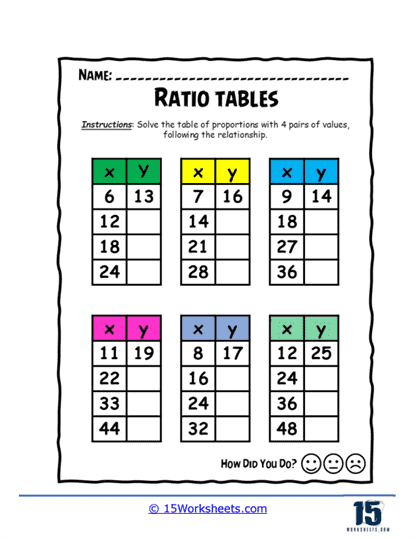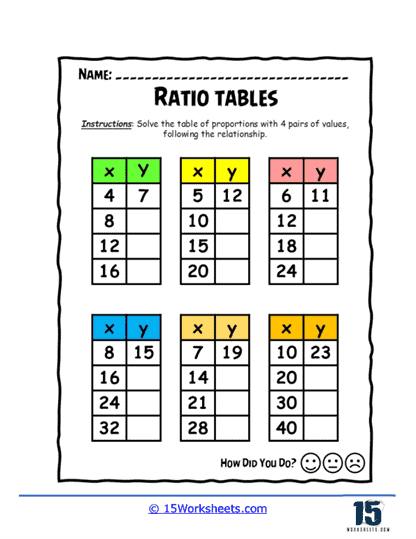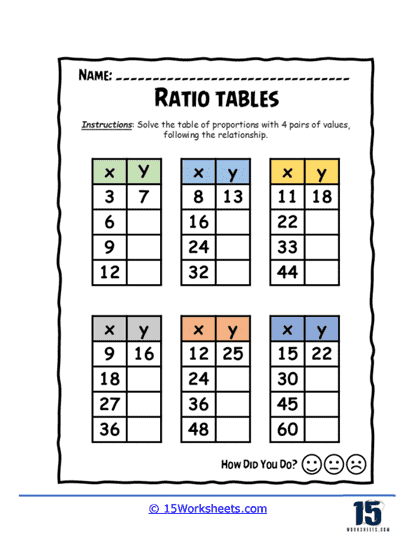Ratio Tables Worksheets
All About These 15 Worksheets
These worksheets were developed to help students understand and solve problems involving ratios and proportional relationships. These worksheets are particularly common in middle school math curricula, as they provide a structured and visual way for students to explore how quantities relate to each other. A ratio is a comparison between two or more quantities, and ratio tables are an effective method for organizing and interpreting this information in a clear, systematic way.
At their core, ratio tables allow students to compare quantities by setting up a table where the relationship between two or more variables can be seen and extended. The most common type of ratio table involves two columns: one for each quantity in the ratio. For example, if the ratio between apples and oranges is 2:3, a ratio table would list multiples of these values in two separate columns. The first row would show 2 apples to 3 oranges, the second row might show 4 apples to 6 oranges, and so on, continuing the pattern. By seeing this progression, students can grasp how ratios scale up or down while maintaining the same proportional relationship.
Types of Exercises
Ratio table worksheets come in various forms, depending on the complexity and focus of the lesson. Each type serves a specific purpose, reinforcing different aspects of ratio understanding and practical application.
1. Basic Ratio Tables
In basic ratio table worksheets, students typically fill in missing values based on a given ratio. For instance, if the initial ratio of two quantities is 4:5, the table might ask students to extend this ratio to find how many of the second quantity would correspond to 8 of the first quantity. This basic format encourages students to focus on multiplicative reasoning, understanding that they must multiply both quantities by the same factor to maintain the ratio. Worksheets may provide partial tables and ask students to complete them, or they might present a complete table for students to analyze.
2. Unit Rates
Some ratio table worksheets focus on unit rates, which are ratios where one quantity is compared to a single unit of the other quantity. A classic example is miles per hour. Students are asked to determine how much of one quantity corresponds to exactly one of the other. For instance, if a car travels 60 miles in 3 hours, students must calculate how far the car would travel in 1 hour. These problems are practical, emphasizing the real-world importance of unit rates in areas like speed, cost, and density. Worksheets might start by having students calculate unit rates and then use the unit rate to complete a ratio table for larger or smaller quantities.
3. Scaling and Proportions
Ratio table worksheets often include exercises that involve scaling quantities up or down while maintaining proportionality. In these activities, students are asked to use the ratio table to answer questions such as, “If 3 gallons of paint cover 600 square feet, how many square feet can 5 gallons cover?” These worksheets help reinforce the idea that proportional relationships remain consistent when both quantities are scaled by the same factor. Scaling questions are common because they tie closely into real-world applications, such as cooking recipes, shopping discounts, and map reading.
4. Multi-Step Problems
In more advanced worksheets, students encounter multi-step problems that require them to use ratio tables as part of a larger problem-solving process. These worksheets might present a scenario where students need to first determine the ratio between two quantities, then use that ratio to solve a more complex problem. For example, a worksheet might describe two machines that produce widgets at different rates, and students are asked to determine how many widgets each machine produces over varying time periods. Multi-step problems encourage students to think critically and apply ratios to broader contexts.
5. Word Problems
Ratio tables are often used in conjunction with word problems, where students must interpret a real-world situation, extract the relevant ratio, and then use a ratio table to find a solution. Word problems might involve shopping scenarios (e.g., “If 4 shirts cost $60, how much would 7 shirts cost?”), cooking (e.g., “If a recipe calls for 2 cups of flour for 3 servings, how much flour is needed for 9 servings?”), or travel (e.g., “If a car travels 150 miles in 3 hours, how long will it take to travel 250 miles?”). These problems challenge students to connect the abstract concept of ratios with concrete, everyday experiences.
6. Comparing Ratios
Another type of exercise found in ratio table worksheets involves comparing different ratios. Students might be given two ratio tables and asked to determine which one represents a larger or smaller relationship. For example, a worksheet might show the ratio of cats to dogs in two neighborhoods and ask students to determine which neighborhood has a higher ratio of cats to dogs. These exercises help students develop a deeper understanding of ratios by comparing different proportional relationships, which is an important skill in both math and science.
7. Fractions and Ratios
Some worksheets integrate the concept of fractions with ratios, asking students to convert between the two. For instance, if a ratio table shows 3:4, students might be asked to express this as a fraction (3/4). Conversely, students might be given a fraction and asked to create a ratio table based on it. This type of worksheet emphasizes the close relationship between ratios and fractions, helping students see how they can use similar reasoning for both.
Real-World Applications
Practicing with ratio tables can provide students with essential skills that are directly applicable in real-world scenarios. Understanding ratios is crucial in many aspects of daily life, and ratio tables provide a clear, organized way to think about these relationships.
1. Everyday Decision-Making
One of the most immediate benefits of mastering ratio tables is the ability to make more informed decisions in everyday life. For example, when shopping, people often encounter products sold in different quantities or sizes at varying prices. A solid understanding of ratios helps consumers determine which product offers the best value for money. Ratio table worksheets teach students how to calculate unit rates and compare different offers, which is a valuable skill for budgeting and financial decision-making.
2. Time Management and Planning
Ratio tables also help students develop better time management and planning skills. In real life, people frequently need to scale tasks based on time constraints. For example, if someone knows it takes 2 hours to clean a house with two people, how long will it take if they have three people helping? Ratio tables make it easier to visualize these kinds of scaling problems, helping students plan more efficiently in their daily routines.
3. Cooking and Recipes
In the kitchen, understanding ratios is vital when scaling recipes up or down. If a recipe is designed for 4 servings but you need to make enough for 10, ratio tables can help adjust the quantities of ingredients proportionally. This ensures that the meal maintains the correct balance of flavors, which is crucial for both novice and experienced cooks. Worksheets that focus on scaling recipes give students practical experience with these types of problems, preparing them for situations they will likely encounter in their personal lives.
4. Business and Economics
In the business world, ratios and proportional reasoning are used to analyze financial data, calculate profit margins, and forecast growth. A company might compare the cost of materials to the number of units produced, or analyze sales trends over time to project future earnings. Ratio tables provide a foundational understanding of how to manage these relationships. By practicing with ratio table worksheets, students gain a deeper understanding of how ratios are used in business settings, which can be beneficial for anyone interested in careers in finance, marketing, or entrepreneurship.
5. Science and Engineering
Ratios are also fundamental in scientific fields. Scientists use ratios to describe relationships between different measurements, such as speed, density, and concentration. Engineers frequently rely on ratios to create models and designs, ensuring that structures are built to scale and function properly. Ratio table worksheets prepare students for these types of technical challenges, providing the mathematical foundation they will need to succeed in STEM (Science, Technology, Engineering, and Mathematics) fields.
What Are Ratio Tables?
A ratio table is a mathematical tool used to organize and display equivalent ratios, which are pairs of numbers that maintain the same relationship or proportion. Essentially, it’s a grid or table that helps to easily identify how quantities increase or decrease in proportion to one another. By listing out several equivalent ratios, a ratio table allows you to scale numbers up or down while preserving their proportional relationship.
For instance, if you are comparing the ratio of apples to oranges in a basket, and you know that for every 2 apples there are 3 oranges, you can use a ratio table to calculate how many oranges there will be if you have 4, 6, or 10 apples. The table might look like this:
















